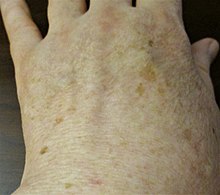| Liver spot | |
|---|---|
 | |
| Liver spots (solar lentigo) on the left hand of a 63-year-old light-skinned Caucasian man | |
| Specialty | Dermatology |
Liver spots (also known as age spot, solar lentigo,[1] "lentigo senilis",[1]: 686 "old age spot",[2] "senile freckle")[2] are blemishes on the skin associated with aging[3] and exposure to ultraviolet radiation from the sun.[4] They range in color from light brown[5] to red or black and are located in areas most often exposed to the sun, particularly the hands, face, shoulders, arms and forehead, and the scalp if bald.
The spots derive their name from the fact that they were once incorrectly believed to be caused by liver problems, but they are physiologically unrelated to the liver, save for a similar color.[6] From the age of 40, the skin is less able to regenerate from sun exposure, and liver spots are very common in this age group, particularly in those who spend time in the sun.[7]
In the overwhelming majority of cases, liver spots pose no threat and require no treatment, though they occasionally have been known to obscure the detection of skin cancer. However, despite being a benign condition, liver spots are sometimes considered unsightly and some people choose to have them removed. This can be done by electrosurgery, laser treatment, cryotherapy, or the use of depigmentation agents, such as hydroquinone,[8] tretinoin,[8] topical cysteamine,[9] azelaic acid,[10] or alpha hydroxy acids.[11]
- ^ a b James, William D.; Berger, Timothy G.; et al. (2006). Andrews' Diseases of the Skin: Clinical Dermatology. Saunders Elsevier. ISBN 0-7216-2921-0.
- ^ a b Rapini, Ronald P.; Bolognia, Jean L.; Jorizzo, Joseph L. (2007). Dermatology: 2-Volume Set. St. Louis: Mosby. pp. 1716–17. ISBN 978-1-4160-2999-1.
- ^ "Age spots (liver spots) - Diagnosis and treatment - Mayo Clinic". www.mayoclinic.org. Retrieved 2020-07-07.
- ^ "Ultraviolet (UV) Radiation". www.cancer.org. Retrieved 2020-07-07.
- ^ Publishing, Harvard Health (5 August 2015). "5 skin spots you shouldn't worry about". Harvard Health. Retrieved 2020-07-07.
- ^ Karen J. Carlson, Stephanie A. Eisenstat, Terra Diane Ziporyn, The new Harvard guide to women's health, Harvard University Press, 2004, p. 337.
- ^ "Age spots: Causes, symptoms, and treatment". www.medicalnewstoday.com. 2018-10-09. Retrieved 2020-07-07.
- ^ a b "Age spots (liver spots) Treatments and drugs". Mayo Clinic. Retrieved 2017-02-12.
- ^ Mansouri, P.; Farshi, S.; Hashemi, Z.; Kasraee, B. (2015-07-01). "Evaluation of the efficacy of cysteamine 5% cream in the treatment of epidermal melasma: a randomized double-blind placebo-controlled trial". The British Journal of Dermatology. 173 (1): 209–17. doi:10.1111/bjd.13424. ISSN 1365-2133. PMID 25251767. S2CID 21618233.
- ^ Rodríguez Prieto, M. A.; Manchado Lopez, P.; Ruiz Gonzalez, I.; Suarez, D. (1993-05-01). "Treatment of lentigo maligna with azelaic acid". International Journal of Dermatology. 32 (5): 363–64. doi:10.1111/j.1365-4362.1993.tb01475.x. ISSN 0011-9059. PMID 8505164. S2CID 29546141.
- ^ "Overview about liver spots/age spots". Beauty Natural Skin. Retrieved 3 July 2015.